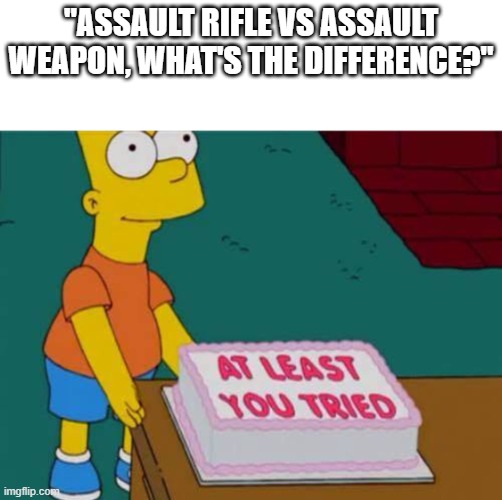
I’m being serious, actually. I’m impressed with the level of detail that Cox Media Group writer Debbie Lord put into this. It has some easy to avoid errors, but it appears to have been a faithful attempt.
Why I bring this up is that this new space, and others like it, are where the normie crowd is reading about what an assault weapon is or can do. The hardcore anti’s are into Giffords or Vox but the silent majority among the less vehement crowds get their info from sources like this.
The terms “assault weapon” and “assault rifle” are used a lot, but when it comes to the two separate types of weapons, there is a great deal of difference.
What is an assault weapon, how does it work and how is it different from an assault rifle? Here’s a quick look.
What is an “assault rifle”?
An assault rifle is a rapid-fire, magazine-fed rifle designed for military use. It is a shoulder-fired weapon that allows the shooter to select between semi-automatic (requiring you pull the trigger for each shot), fully automatic (hold the trigger and the gun continuously fires) or three-shot-burst modes.
That’s… actually pretty good. Far better than average in defining an assault rifle. This definition is functional if incomplete. About the only missing element is the intermediate caliber portion, which is small potatoes overall, and the error in the assumption that all assault rifles have all of the selectable modes.
Properly, an assault rifle is a select-fire, box magazine fed rifle of intermediate caliber. Selections for fire mode include combinations of semi-automatic with a burst of 2 or 3 rounds or fully automatic mode, and with some designs integrating more than two selections, in addition to the safe selection.
Intermediate caliber is important when discussing the alleged ‘power’ of a rifle, which is often brought up in the debate over ‘assault weapons’ as being particularly powerful. As the caliber of assault rifles, and thereby semi-auto only rifles that fire the same ammunition and function similarly, is intermediate, there power is therefore intermediate on the scale of rifles.
But we can’t very well have a heated and hyperbole drenched debate over powerful weapons of war when we’re talking about something mid-at-best on the old power scale, and don’t anyone bring up how the assault rifle is effectively second only to the sidearm as the weakest military weapon by a very large margin.
We’re off to a fairly informative start here. I am overall impressed. Nicely done, Debbie Lord.
What is an “assault weapon?”
Technically, there is no such thing. What’s called an assault weapon (or sometimes an assault rifle) in reports on gun violence is a semi-automatic rifle that looks similar to the assault rifles used by the military. An AR-15 rifle, like one that has been used in some mass shootings, is an example of this type of weapon.
It is possible. It really is possible. Mass media, please take note, Debbie just dunked on all of you and whatever grade of panicky gun rant you are used to publishing as news. It’s a rifle that looks similar to assault rifles.
I’ll go even further, most of them share their majority of parts with assault rifles just like a police cruiser or secret service SUV and the same model commercial SUV do.
Debbie is 2 for 2 on usable definitions and the scarcity of places I can say that is depressing.
Let’s keep going.
What’s the difference between a semi-automatic and an automatic weapon?
An automatic weapon (“assault rifle”) can shoot more than one round when you pull the trigger. A semi-automatic weapon (“assault weapon”) does not.
Automatic weapons have not been used in recent mass shootings. In the shootings in Orlando, New Town, Connecticut, and San Bernardino, semi-automatic weapons, one requiring you to pull the trigger each time to fire a cartridge, were the weapons used.
3 for 3, I will give Debbie benefit of the doubt in that an assault rifle is a type of automatic weapon and that her use of the terms assault rifle and assault weapon in both quotes and parenthesis are to maintain reader orientation on connecting the terms.
The weapon used in some of those shootings was an AR-15. Doesn’t “AR” stand for “automatic rifle”?
No, “AR” in the gun’s name stands for Armalite Rifle. That is the company that first developed the weapon nearly 60 years ago. The company sold the rights to the firearm to the Colt company which, in turn, modified the rifle and sold it to the military as the M-16. The M-16 is an automatic weapon: Hold the trigger and multiple rounds can be fired. The AR-15, like the Sig Sauer, requires that you pull the trigger to fire each cartridge.
3.9/4
We’re now confusing the issue and misinforming the readers with the introduction of ‘the Sig Sauer’ in the final sentence. Sig Sauer is a company, they even make a line of AR-15’s and AR-10’s. They make several military assault rifles too for the US and international customers.
Sig Sauer is a large manufacturer of weapons, optics, and ammunition. To say “like the Sig Sauer” and in context with defining semi-automatic weapons muddies the issue. Yes, the commercial Sig Sauer products are semi-automatic or manual action when it comes to firearms but that is far from clarifying on the issue for a normie reader.
FN did a study several years ago now, in that study they were trying to figure out if FN was a ‘household name’ and it turns out that, shockingly, it isn’t. You, reader, probably know who FN is and so do I but we’re consumers in this market space, FN wants us to know who they are because the likelihood they have a product we want in exchange for some money is much much higher than someone primarily perusing Amazon, Home Depot, or Wal-Mart. Those are truly nationally recognized and interacted with brands where any firearm company, to include Springfield, S&W, Ruger, or Taurus, all of which have massive market shares, are still niche on the grand scale.
So speak to the normie, orient them on who Sig Sauer is and what they make and in reference back to the context of the article like we started.
If it is not an automatic weapon, how does a shooter fire so many shots?
Hmm, I have a feeling we’re going to get silly now…
Semi-automatic rifles can accommodate high-capacity magazines – compartments that hold cartridges. That allows the shooter to fire off dozens of rounds in a short period of time. A Sig Sauer and an AR-15 magazine generally holds 20- 30 rounds. There are magazines that can hold more.
I was correct.
3.9/5
I can see where Debbie was going but we got lost and distracted. We used shots, cartridges, and rounds all in the query and three sentence explanation without first establishing that those are linked or interchangeable terms, especially round and cartridge.
At the end here I’m left feeling that it is the magazine that determines the rate of fire whether its an assault rifle or a semi-auto rifle, and maybe even a handgun if I know those have magazines.
This section needed more.
Let’s stick to the format Debbie used and fix the meandering information.
Semi-automatic rifles are also known as auto-loading rifles, or shortened to auto-loaders. This is true for handguns and shotguns that are semi-automatic as well. What an auto-loading firearm does is automatically reload the firearm for the next shot, using some of the firing cartridge’s energy. This reload happens very quickly thanks to the simple mechanisms involved so a semi-auto can effectively fire as fast as the shooter can pull and re-pull the trigger.
Semi-automatics load their ammunition from a magazine, a simple spring loaded box or tube that will push a new round into position to be loaded when the currently loaded one gets fired and then removed from the gun. As long as the magazine has rounds in it, it will keep putting them into place to be loaded. Magazines on semi-automatic rifles commonly hold 20 or 30 rounds, allowing for that many shots before needing to reload a new magazine or refill the single magazine. Larger magazines than that exist too, accommodating 40, 50, 60, or even 100 rounds.
How quickly and how many shots can be fired is limited mostly by how many magazines, not how large they are, and how good at changing them or refilling them someone is. Additionally, that is only about the efficiency of firing the shots, not about hitting anything or anyone or there actually being anything or anyone to hit.
There, it took three paragraphs and not three sentences but we’ve conveyed the information the question asks, which is not as simple as the single sentence may indicate. It’s the difference between answering “Where do babies come from?” with “From Mommy’s tummy.” or an actual basic rundown of the reproductive process. We needed the second answer here and Debbie unfortunately delivered us a mangled version of the first.
How tough is it to get a semi-automatic weapon?
In most cases, it’s no tougher to get a semi-automatic rifle than it is to get a handgun. Seven states — California, Connecticut, Hawaii, Maryland, Massachusetts, New Jersey and New York – and the District of Columbia have enacted laws banning semi-automatic weapons. Minnesota and Virginia regulate semi-automatic weapons. There is no ban on purchasing the weapons in any other state.
In Florida, you do not need a license to own or purchase a handgun, shotgun or rifle, nor do you have to register a gun. To purchase a gun from a gun store, you must pay $8 and complete the paperwork for a background check. If you pass the background check, you get the gun. If the gun is a rifle or a shotgun, you do not have to wait three days to get it. For a handgun, there is a mandatory 3-day “cooling off” period in Florida, one of only 10 states that require any waiting period for the purchase of a gun. There is no federal waiting period required when purchasing a gun. Waiting periods are imposed by states.
And we’re totally lost now. Grading ceases.
In most cases, it’s no tougher to get a semi-automatic rifle than it is to get a handgun.
Which is accurate, in many cases its a little easier because rifle purchases begin at 18 and handguns are 21. The issues begin in full in the next sentence.
Seven states — California, Connecticut, Hawaii, Maryland, Massachusetts, New Jersey and New York – and the District of Columbia have enacted laws banning semi-automatic weapons. Minnesota and Virginia regulate semi-automatic weapons.
Those seven states have not banned semi-automatics, they have some version of ‘assault weapons’ bans which ban certain semi-automatics by certain features, several do similarly with handguns on an approved or disallowed list. These systems are objectively terrible at risk assessing firearms by any objective measure and are about to go through the constitutionality referendum for their continued legal existence.
The second paragraph gets us lost in the complexity of the Federal and state background check systems, and its a mess.
Let’s do as we did previously. Same format, clearer information.
In most states, it’s no tougher to get a semi-automatic rifle than it is a handgun or shotgun. Federally, they are all considered Title I firearms, or what could be called normal firearms, with the only difference between acquiring a handgun and acquiring a rifle or shotgun is that a handgun requires the purchaser to be 21 years of age while the rifle and shotgun require to purchaser to be 18 years of age.
Purchases start pretty much the same way in all states and for all firearms, the Federal 4473 paperwork is filled out and filed for a background check. A few states use their own state systems or both the federal and state systems but the process is similar. Most background checks clear very quickly, delayed checks usually clear within a few days. There is a federal law limiting the amount of time the government can take on a background check to avoid undue delay to the purchaser, this is noted as the Brady Transfer Date and is given by the background check system at the time of the check. The firearm being purchased can be transferred to the purchaser on or after that date if the government does not produce a definitive answer within that time frame, usually three business days. States like Illinois have a special firearm owner ID, a FOID, which is another check of state data nearly identical to what occurs at the time of purchase. States like Michigan require registration of handguns with the state. Once the background check clears, most states will let you leave with your purchase, some have waiting periods after your background check has been passed depending upon the firearm. Length of wait time depends on the state.
Can I buy an automatic weapon?
Here’s where you need to understand the difference between automatic and semi-automatic. Semi-automatic weapons are relatively easy to purchase. However, the only automatic weapons legal to purchase for civilians in the United States are the ones that have been registered between 1934 and 1986. According to the Bureau of Alcohol, Tobacco, Firearms and Explosives, an “assault rifle” (or automatic weapon) is a machine gun. No new machine guns can be made or sold to civilians. Automatic weapons have been heavily regulated since the National Firearms Act of 1934.
Taking possession of such weapons requires paying a $200 federal transfer tax, filling out an application to register the weapon, submitting passport photos, getting your chief law enforcement official to sign your application, and submitting to an FBI background and fingerprint check. Those weapons are hard to come by and generally pretty expensive. You do not want to violate the Firearms Act. If you do, expect to sit in prison for 10 years as you figure out how to pay the $100,000 fine.
Suddenly we’re back on track. That isn’t a bad summation of the NFA process and the limits on transferable automatic weapons.
Final grade, roughly 4.9/7 major points within a piece meant to inform and clarify.
Why Address This?
Because when a GenPop Normie, someone with a truly average range level of firearm knowledge and competency measured against the general population, is talking to you about assault weapons, bans, gun control and so forth, this is the type of work they are referencing.
Getting mad at them for it or deriding their understanding isn’t going to go far in changing their mind. It wasn’t their idea, they just read it from a source they trusted because that source also tells them about the weather, the school closings, the armed robbery at the gas station that happened late last night, and some of the generalized goings on and happenings in the world. It does so with passable accuracy.
When we stray into topics like firearms or medicine, which require expertise in their sourcing and checking your work for accuracy, things can derail quickly. Especially on a topic like background checks which are complex.
The concept of a background check is simple, the process is complex. This is likely why the concept of a ‘Universal Background Check’ is so popular when put forward, and consequently why when we argue against them the arguments seem to be the unreasonable ones. We are arguing from the place of greater understanding but without properly sharing that understanding of the complex implementation of a simple concept. It is an uphill battle and one that we won’t succeed at often because folks just stop caring beyond a level of complexity if they don’t have to interact with that complexity, it isn’t their problem. They then default back to the simplicity of the concept, rather than the reality of implementation, to justify their stance to themselves.
So for GenPop discussions, especially when they’re wrong on [topic] it is important to remember to be more ‘gentle but firm’ in our rebuke and correction rather than the outright hostility we can get away with on the terminally stupid. We don’t need to change the terminally stupid minds, its an impossible task and they already believe firearms are the root of all evil, at least until you change topics, and they cannot be bothered to critically think the issue through. But for those who are just earnestly professing their opinions on topics based upon their level of understanding, our first goal should be to further their understanding. A change of understanding usually changes opinion, unless the held opinion is dogmatic rather than reasoned which tends only to be true out of ideologues and not GenPop casuals.



